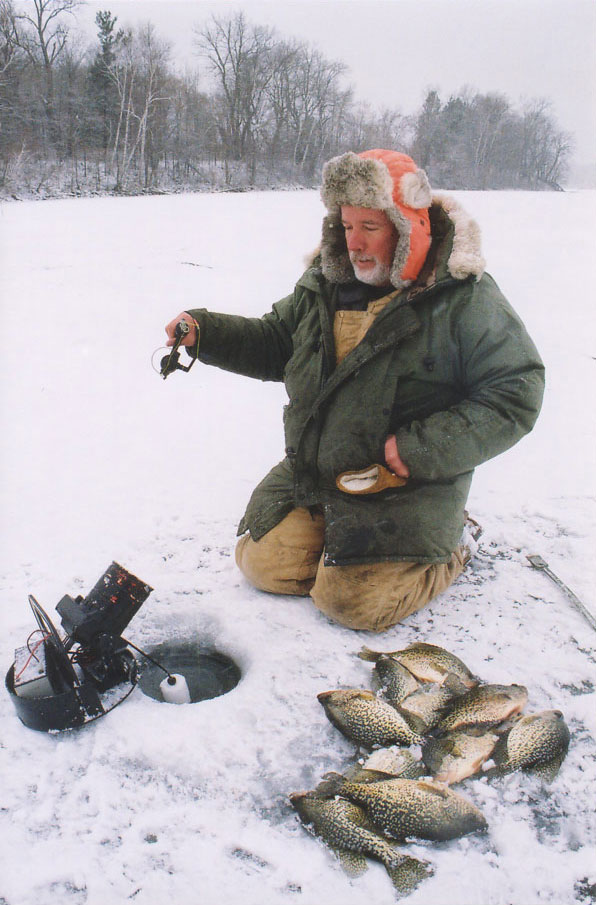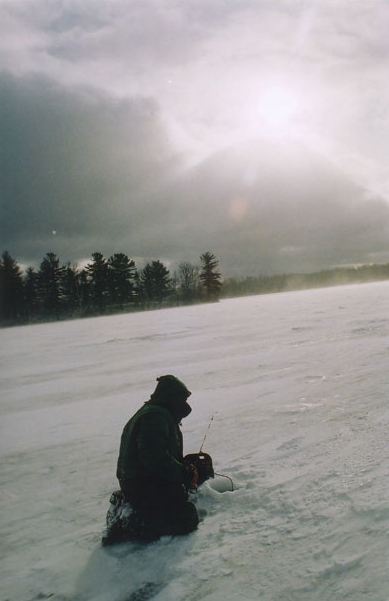Sawyer County: Big Crappies Lead The Chase
By Dick Ellis
The battle here on the Sawyer County hardwater was as much with the January elements as with this roving band of big crappies being picked off one by one in an angler’s game of hit and run.. Sitting still over an augured hole or two would work. The fish will come by again eventually. But the stationary ambush is not the main chapter in the Bill and Jim Whiteside book on advanced crappie fishing.
These studies feature the chase, and the calculated rendezvous. The fish are moving and so too must you. A frozen landscape painted with miniature, auger-sculpted mountains of chipped ice had already been made as this pursuit continued. Leave a hole unattended too long, though, or a fish on the ice, and it would soon be gone with the winds; frozen or buried under 40 miles per hour gales, periodic squalls of horizontal snows, and numbing cold.
 The front came on from the north, stirring up the snow, stirring up the fish to move, move, move, and shutting down significantly what had been a fabulous bite the day before. So even with their Vexilars on the ice, enough love for the sport to spit at the storm, and a lion’s share of Ice Man’s know-how in their souls, today’s game was a true challenge of cold-blooded perseverance. Conditions had kept all but the heartiest anglers away.
The front came on from the north, stirring up the snow, stirring up the fish to move, move, move, and shutting down significantly what had been a fabulous bite the day before. So even with their Vexilars on the ice, enough love for the sport to spit at the storm, and a lion’s share of Ice Man’s know-how in their souls, today’s game was a true challenge of cold-blooded perseverance. Conditions had kept all but the heartiest anglers away.
“You just don’t find many lakes with this nice of crappies,” said Jim Whiteside, ten fish from 10-1/2 to 14 inches piled on the ice. “The challenge today is getting the big ones up to the hole that’s freezing over and then they’re often too big to get out of the hole. You have to get your hand down into the hole to help the fish out of the water; otherwise you break your line. Small crappies you can reef out. But not these fish.”
To date, it had been a difficult winter of icefishing the northwest for the Whitesides, of Eau Claire. Fishing five lakes near home and five in closer proximity to Spooner and Hayward, crappies had been elusive. Sissabagma, Sand, Big Chetak, Long, and Lac Courte Oreilles all within a 25 miles setting in Washburn and Sawyer counties, had each proven stingy. On one of those lakes, which will remain your guess out of respect for the locals and the lake, the worm finally turned last week.
“All of these lakes have good potential panfish, including big crappies,” Bill Whiteside said. “Periodically, each of the lakes will turn on. There’s no reason to highlight one lake because we fish them all and will continue to.”
Regardless of lake, the Whiteside tactic of hide and seek remains the same. That means drilling enough holes where the crappies, most often a schooling fish, can be located on the Vexilar and then follow as the fish move. But there are no guarantees.
“You might see three, four, five fish at a time on the screen and pretty soon they’re gone,” Bill said. “So you leave that hole and go to another. Sometimes you go to where they were, sometime you can guess by their movement that they’re going to a new area and you go drill new holes. But I’ve already drilled 100 holes and not found the fish. If you found them every time out there wouldn’t be any left anyway.”
When the fish are found, suspended in 20 to 22 feet of water this day, the Whiteside arsenal includes two-pound test line, #8 moonglows dressed in three silver wigglers (spikes) and open-faced reels on short jigging rods. And the all-important Vexilar.
“I drop the bait after I spot them on the vexlar and leave it just above the fish,” Bill said. “After a few seconds I try to take it away from them, not too fast but fast enough to make the fish pull the trigger. They like to come up for it.”
“That’s part of the secret,” Jim said. “You’ve got to have the right touch even if you’ve got to tease them. The jigging motion makes a world of difference.”
The chase continued on this winter land cuckoos nest. The storm chases the fish. The anglers do too. And a reporter with a camera chases the storm, the anglers and the fish to catch the sun slicing a squall, or another slob coming through the ice.
The day before, the Whitesides had each caught a 25 fish limit, their first good action of the season searching once a week. On this day, after a lot more moving and drilling, and a lot more time, they would take a collective 30 fish.
“When the wind switched and the front moved in, the fish started moving more and more and it was harder to stay with them,” Bill said. “They’re here. Then they’re gone. It’s a lot tougher. But if you catch 10 or 15 that’s plenty for a family meal or two.”
The movement, the work, the ultimate challenge in finding the fish is what brings Jim Whiteside back to the ice. Sometimes hitting pay dirt means hours of searching. And sometimes pay dirt remains a “well, maybe next time” idea.
“More than anything I don’t like to watch a tip-up,” he said. “I like the challenge of trying to get your fish. You have to keep up with them. Keep looking. Hole to hole. If you get one fish out of one hole, you’re doing good. Sometimes you can fill up in a couple hours. And sometimes you don’t fill up at all. It all depends on if you find them.”
Photo 1: Jim Whiteside showed his crappie stuff on several Sawyer and Washburn County lakes. Photo by Dick Ellis.
Photo 2: Bill Whiteside heads into the teeth of a storm to head-off crappies on the run on many northwest Wisconsin lakes. Photo by Dick Ellis.
TWO MINUTES OF TIPS FROM A WISCONSIN ICE MAN
From one winter to the next, schools of crappies may not be found in the same area of a lake, said Bill Whiteside of Eau Claire. Unlike the bottom-hugging perch, crappie will also be suspended, most often two to five feet off the bottom.
At times, drilling numerous holes to initially locate crappies will be necessary, particularly when the fish are not moving aggressively. When they are moving, crappie will often come to the angler with just a few holes drilled and be seen on the Vexilar. More holes, of course, will then be necessary to keep on those roaming schools.
“When you find them they still may not be easy to catch,” Whiteside said. “You still have to get them to hit. You need confidence in your bait of choice and confidence in how you jig or move that bait, regardless of conditions.”
He recommends a #8 moonglow tipped with three silver wigglers, or spikes and stresses that even a subtle change in jigging motion or movement can make a significant difference in success or failure in triggering strikes. The movement preferred by the fish can be determined by carefully watching the Vexilar so sensitive that the angler can visually follow the tiny jig dropping on the screen.
“Learn from watching the Vexilar, and try to be smooth, not hard or jerky in your motion,” he said. “Especially in mid-winter don’t give up, and don’t be afraid to change your bait or the color of bait.”
It’s because of the modern-day electronics and improved potential of catching fish that Whiteside supports reasonable daily panfish limits. A decasde ago limits were 50 fish per angler per day. “I didn’t like it when it was first reduced from 50 to 25,” he said. “But it was needed.”






